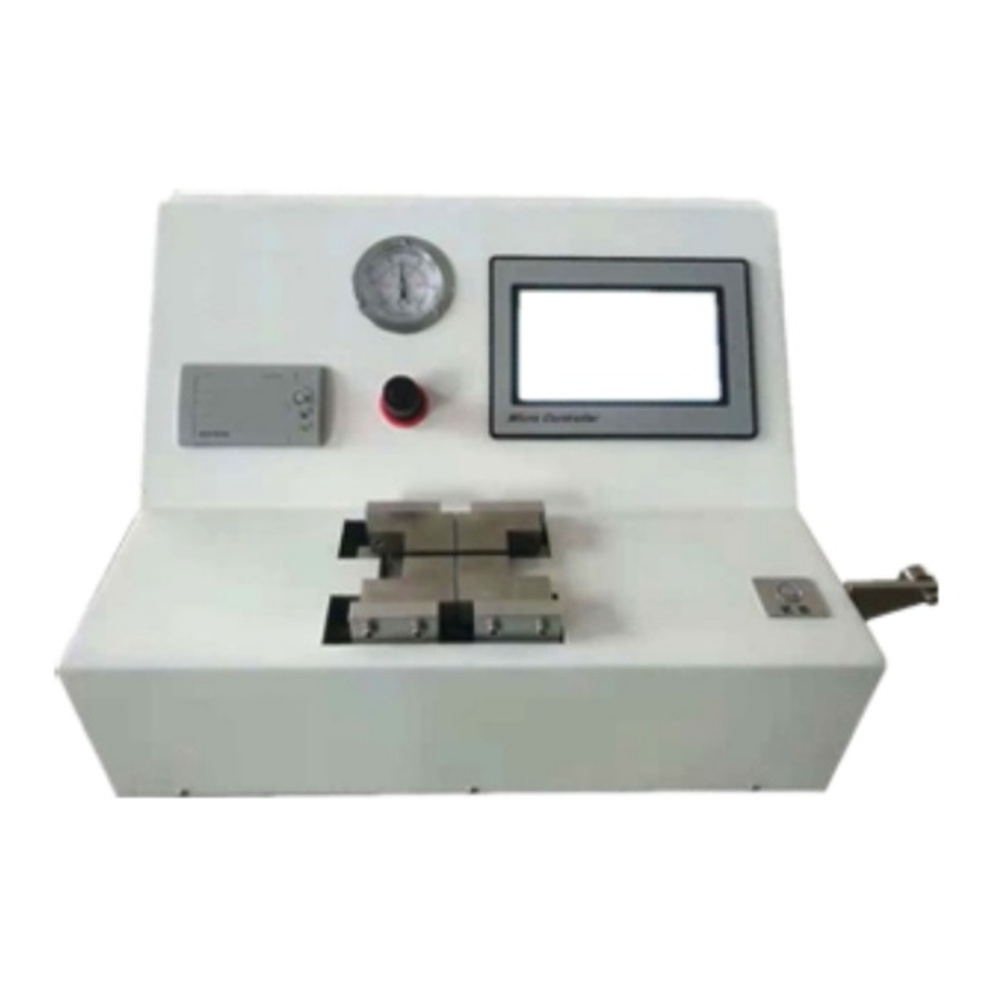Einführung in den Short Span Compression Tester
Der SCT-01 Kompressionstester mit kurzer Spannweite ist ein hochpräzises Instrument zur Bewertung der Druckfestigkeit von Papier und Karton, das wichtige Qualitätseinblicke für Materialien liefert, die bei der Herstellung von Behältern und Kartons verwendet werden. Dieses Prüfgerät eignet sich besonders für Papier und Karton mit einer Grammatur zwischen 100 g/m² und 400 g/m² und stellt sicher, dass nur Materialien mit den erforderlichen Festigkeitsstufen für die Herstellung zugelassen werden. Mit seinem robusten Design und seinen fortschrittlichen Funktionen trägt das SCT-01 zur Optimierung der Produkthaltbarkeit bei und ist damit ein wertvolles Werkzeug für die Qualitätskontrolle in verschiedenen Branchen, darunter Verpackung, Papierherstellung und Qualitätsprüfungsbehörden.
Wichtige Anwendungen
Der SCT-01 Kompressionstester mit kurzer Spannweite ist in vielen Branchen einsetzbar, in denen konstante Materialstärke und Zuverlässigkeit gefordert sind:
- Verpackungsindustrie: Überprüfung der Materialqualität bei der Kisten- und Behälterherstellung, entscheidend für Transport und Lagerung.
- Papier- und Kartonherstellung: Sicherstellen, dass die Materialien Belastungen sowohl in Maschinenrichtung als auch quer zur Maschinenrichtung standhalten, wodurch die Haltbarkeit erhöht wird.
- Qualitätsprüfungsagenturen: Bereitstellung einer standardisierten Testmethode für Konformitätsprüfungen gemäß ISO 9895.
Systembeschreibung des SCT-01 Short Span Compression Testers
Der SCT-01 Kompressionstester mit kurzer Spannweite ist mit Präzisionsklemmen und einem robusten Klemmmechanismus ausgestattet, um genaue Prüfungen zu gewährleisten:
- Klemmen: Der Tester verfügt über zwei Klemmen mit jeweils 30 mm Länge und festen und beweglichen Backen. Diese Backen sind mit einer Oberfläche mit hoher Reibung versehen, um während der Tests einen festen und gleichmäßigen Halt zu gewährleisten.
- Klemmkraft: Es übt eine konstante Klemmkraft von 2300 ± 500 N aus und hält das Prüfstück sicher über seine gesamte Breite.
- Kieferausrichtung: Die feststehenden und beweglichen Backen sind parallel, sodass bei jedem Test die Einheitlichkeit gewährleistet ist und genaue Messungen möglich sind.
- Pneumatische Klemmung und einstellbare Prüfgeschwindigkeit: Das pneumatische Klemmsystem des Testers mit anpassbarer Kraft und einstellbarer Geschwindigkeit ermöglicht Flexibilität und Anpassung an verschiedene Testanforderungen und Materialtypen.
Prüfprinzip der Short-Span-Compression-Prüfung
Der SCT-01 Kompressionstester mit kurzer Spannweite basiert auf einem einfachen, aber zuverlässigen Testprinzip:
- Eine 15 mm breite Testprobe wird zwischen zwei Backen eingespannt, die zunächst einen Abstand von 0,70 mm haben.
- Anschließend drücken die Backen die Testprobe zusammen, bis sie unter der ausgeübten Kraft nachgibt.
- Die maximal ausgeübte Kraft vor dem Druckversagen wird aufgezeichnet und dieser Wert wird zur Berechnung der Druckfestigkeit des Materials verwendet.
Diese Methode liefert zuverlässige, wiederholbare Ergebnisse und hilft Herstellern, die Festigkeit des Materials in realen Anwendungsumgebungen zu bestimmen.
Überblick über ISO 9895 und seine Testmethoden
Der SCT-01 Short Span Compression Tester erfüllt die ISO 9895 Standard, ein weltweit anerkannter Maßstab zur Beurteilung der Kurzspanndruckfestigkeit von Papier und Karton.
- Einführung in ISO 9895: ISO 9895 legt Verfahren zur Bestimmung der Druckfestigkeit fest und leitet den Einrichtungs- und Testprozess an, um Konsistenz zwischen verschiedenen Laboren und Branchen zu gewährleisten.
- Anforderungen an die Testmethode: ISO 9895 beschreibt die Abmessungen der Prüfstücke, spezifische Spannkräfte, Spanngeschwindigkeiten sowie Berechnungen für die Druckfestigkeit und ermöglicht so standardisierte Prüfungen für genaue, vergleichbare Ergebnisse.
- Bedeutung der ISO 9895-Konformität: Die Einhaltung der ISO 9895 garantiert, dass das SCT-01 zuverlässige und genaue Messungen der Druckfestigkeit liefert, was für Branchen von entscheidender Bedeutung ist, die internationale Qualitäts- und Haltbarkeitsstandards erfüllen möchten.
Vorteile des SCT-01 Short Span Compression Tester
Der SCT-01 Kompressionstester mit kurzer Spannweite bietet mehrere Vorteile, die es zur idealen Wahl für Druckprüfungen mit kurzer Spannweite machen:
- Benutzerfreundliche Bedienung: Ausgestattet mit einem SPS-Steuerungssystem und einer HMI für eine unkomplizierte Bedienung minimiert der SCT-01 Bedienfehler.
- Verbesserte Sicherheitsfunktionen: Enthält einen Not-Aus-Schalter und einen Überbereichsschutz, um einen sicheren Betrieb zu gewährleisten.
- Anzeigeoptionen für mehrere Einheiten: Zeigt Testergebnisse in mehreren Einheiten (N, kgf, lbf) an, um eine den Benutzeranforderungen entsprechende Flexibilität zu gewährleisten.
- Erweitertes Datenmanagement: Verfügt über einen integrierten Nadeldrucker zum sofortigen Ausdrucken der Ergebnisse und einen optionalen RS-232-COM-Anschluss mit Software für effiziente Datenübertragung und -speicherung.
Technische Daten des SCT-01
Nachfolgend finden Sie eine Zusammenfassung der wichtigsten technischen Parameter des SCT-01:
| Parameter | Spezifikation |
|---|---|
| Testbereich | 1 bis 500 N (0,06 bis 33,3 kN/m) |
| Kompressionsabstand | 0,3~0,7 mm |
| Klemmlänge | 30 ± 0,5 mm |
| Testgeschwindigkeit | 3 ± 0,1 mm/min |
| Auflösung | 0,01 N |
| Stichprobengröße | 15 mm (Breite) x 75 mm (Länge) |
| Gasdruckbedarf | 0,5 MPa |
| Gasanschlussgröße | Ф6 mm |
| Strombedarf | Wechselstrom 110–220 V, 50 Hz |
Diese Spezifikationen stellen sicher, dass der SCT-01 vielseitig, genau und anpassungsfähig ist und sich somit ideal für den anspruchsvollen industriellen Einsatz eignet.
Compliance und Standards von Kompressionstester mit kurzer Spannweite
Der Short Span Compression Tester SCT-01 entspricht mehreren Normen, was seine Glaubwürdigkeit und Relevanz in professionellen Umgebungen erhöht:
- ISO 9895: Garantiert zuverlässige Messungen der Druckfestigkeit im Nahbereich.
- GB/T 2679.10: Sorgt für regionale Konformität und stellt die Kompatibilität mit Industriestandards in verschiedenen Märkten sicher.
Häufig gestellte Fragen (FAQ)
- Welche Arten von Materialien können mit dem SCT-01 getestet werden?
- Der SCT-01 eignet sich für Papiere und Kartons im Grammaturbereich von 100 g/m² bis 400 g/m², die üblicherweise in der Verpackungs- und Kartonproduktion verwendet werden.
- Wie gewährleistet das SCT-01 genaue Kompressionstestergebnisse?
- Die parallelen und reibungsstarken Backen des SCT-01, die konstante Klemmkraft und die Einhaltung der ISO 9895-Normen gewährleisten hochpräzise und wiederholbare Testergebnisse.
- Warum ist die Einhaltung von ISO 9895 für Komprimierungstests wichtig?
- ISO 9895 legt weltweite Standards für Testmethoden fest und stellt sicher, dass die Ergebnisse zuverlässig und branchenübergreifend vergleichbar sind.
- Wie verbessert die pneumatische Klemmung die Testgenauigkeit?
- Durch die pneumatische Klemmung wird ein konstanter Druck auf die Probe ausgeübt, wodurch ein Verrutschen oder eine Beschädigung verhindert wird, die die Testergebnisse beeinträchtigen könnten.
- Welche Vorteile bietet die Verwendung einer Mehrfachanzeige und einer Datenverwaltungssoftware?
- Über die Mehrfachanzeige können Benutzer die Ergebnisse in unterschiedlichen Einheiten anzeigen, während die Datenverwaltungssoftware die Ergebnisanalyse und die langfristige Aufzeichnung erleichtert und so die Testeffizienz verbessert.





